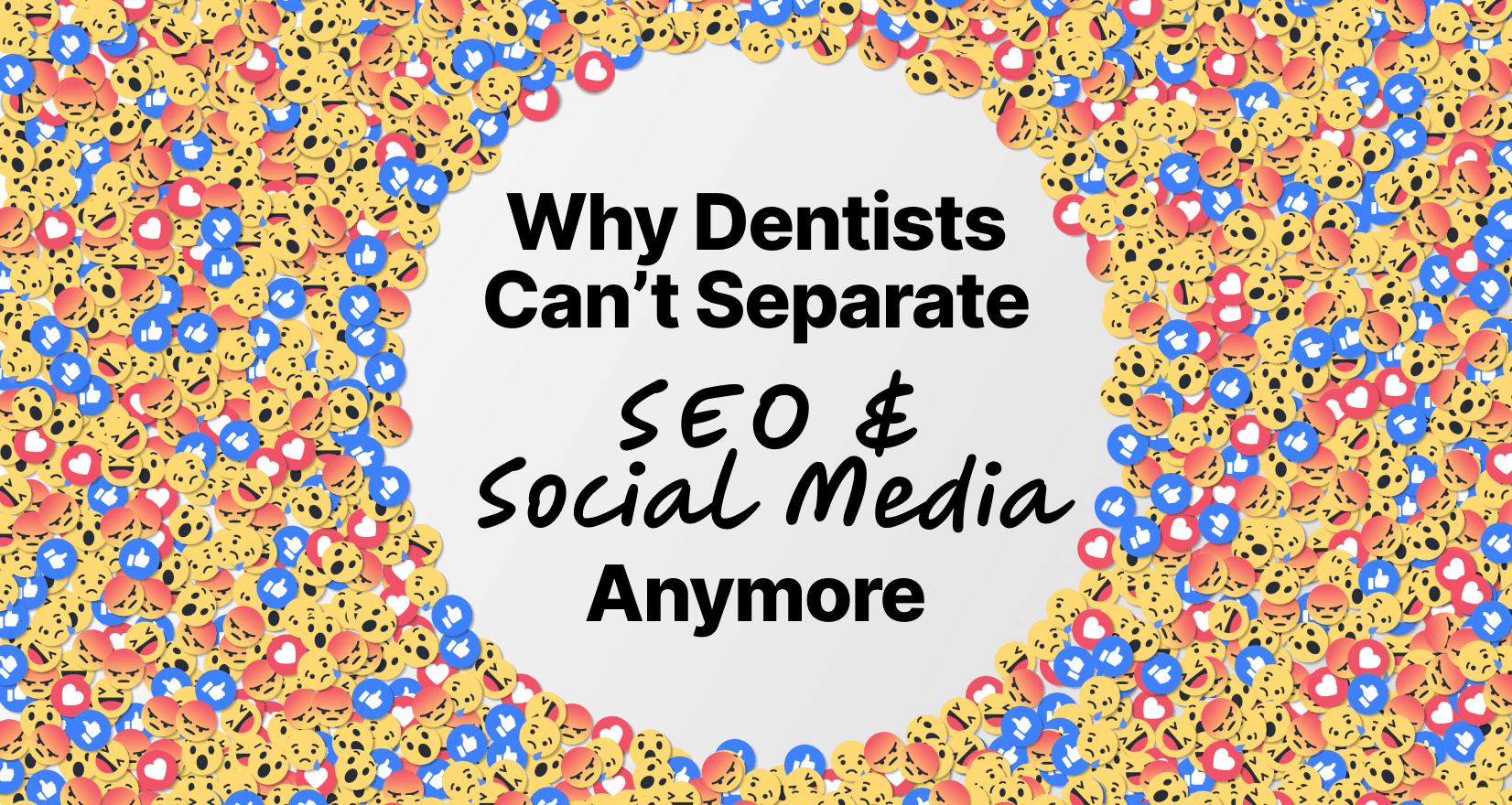
YMYL & Dental SEO: Why Google Holds Your Practice to a Higher Standard
When a patient Googles “emergency dentist near me” or “how much do dental implants cost,” they’re not just looking for casual reading material. (Probably. I guess some people find the details of local dentistry a to be a compelling read.) More likely, they’re making decisions that could affect their health, safety, and financial future. That’s why Google treats dental websites differently than blogs about movies, fashion, or home décor.
In SEO terms, dentistry falls under YMYL, AKA “Your Money or Your Life.” It’s Google’s category for content that could significantly impact someone’s health, happiness, or financial stability. Pages about root canals, sedation, infection control, or treatment costs can literally shape a patient’s well-being and choices.
What does that mean for your practice?
- Your website is held to a higher standard of accuracy, trust, and authority.
- Outdated, vague, or “fluffy” content won’t just hurt rankings. It can hurt credibility with potential patients.
- On the flip side, high-quality YMYL content helps you earn Google’s trust and your community’s trust at the same time.
In this guide, we’ll explain what YMYL means for dentists, how it ties into Google’s E-E-A-T standards (Experience, Expertise, Authoritativeness, Trustworthiness), and the steps your practice can take to create content that both ranks well and reassures patients. And maybe you’ll even create some great bathroom reading content. 🤷
Table of Contents
- What Is YMYL (in Dentist Terms?)
- E-E-A-T for Dental Websites (What Google Looks For)
- How YMYL Changes Your Dental SEO Strategy
- Content Types That Win for Dental YMYL
- Editorial & Compliance Best Practices (So You Don’t Accidentally Tank Rankings)
- Building Authority: Backlinks & Mentions That Actually Help
- Technical Trust Signals Google (and Patients) Notice
- Common Pitfalls (and Safer Swaps)
- Why YMYL Is the Key to Dental SEO Success
- FAQ
What Is YMYL (in Dentist Terms)?
YMYL stands for “Your Money or Your Life.” It’s Google’s way of flagging content that can have a real impact on someone’s health, safety, finances, or overall quality of life. Dentistry checks every single one of those boxes, which is why dental websites are automatically considered YMYL sites. Google holds them to stricter standards than, say, an excellent blog post documenting what dental websites designed by characters from The Office would look like.
Here are some clear examples of YMYL dental content:
- Treatment pages (implants, braces, root canals, whitening, veneers)
- Emergency dentistry guides
- Sedation and anesthesia information
- Financing, insurance, and cost pages
- Post-treatment care instructions
- Safety and infection-control protocols
And here are a few “lighter” types of dental content that Google doesn’t scrutinize as much:
- Social posts about your team’s community events
- Smile-friendly holiday tips (like tooth-friendly Halloween treats)
- Office tours or patient appreciation days
- Fun trivia or lifestyle content (“Foods that stain your teeth”)
Basically, any page that could affect someone’s health or financial decisions is YMYL content and needs to be written, reviewed, and updated with extra care.
E-E-A-T for Dental Websites (What Google Looks For)
If YMYL is the “what,” E-E-A-T is the “how.”
Google uses four factors—Experience, Expertise, Authoritativeness, and Trustworthiness—to decide whether your content deserves a top spot in search results. For dental websites, these are the building blocks to lasting trust.
Experience
Google wants to see content that reflects real, first-hand knowledge. In dentistry, that could look like:
- Photos of your team performing procedures (with patient consent).
- Case examples or before-and-after stories (again, with consent and realistic expectations).
- Patient-friendly insights only a practicing dentist would know, like what recovery really feels like after an extraction.
Expertise
Your credentials matter. Every piece of clinical content should connect back to the qualifications of the dentist or specialist behind it. Ways to showcase this include:
- Adding DDS/DMD or specialty credentials next to your name.
- Using “Medically Reviewed by Dr. [Name]” on treatment pages and blogs.
- Explaining your editorial process: how content is researched, reviewed, and kept accurate.
Authoritativeness
Think of this as your reputation both online and offline. You build authoritativeness by showing your practice is a trusted voice in dentistry:
- A strong About Us page with team bios and professional memberships.
- Citing reputable organizations like the ADA or specialty academies.
- Earning backlinks from other respected sites (universities, hospitals, community organizations, dental journals).
Trustworthiness
This is the most important piece of the puzzle. Patients—and Google—want to know they can trust your website. You build trust by:
- Making it easy to contact your practice (consistent NAP: name, address, phone).
- Clearly displaying office hours, emergency contact info, and directions.
- Adding disclaimers clarifying that web content is educational, not a substitute for professional care.
- Keeping your site secure (SSL, HIPAA-aware forms, privacy policies).
If your content doesn’t reflect E-E-A-T, Google is far less likely to rank it, and patients are less likely to believe it.
How YMYL Changes Your Dental SEO Strategy
For most businesses, SEO is about keywords, backlinks, and content volume. For dentists, that’s true, but with a fun, extra twist. Because your website is YMYL, Google cares less about how much content you publish and more about how accurate, comprehensive, and trustworthy it is. Neat!
Here’s how that changes your approach:
Accuracy beats volume.
A single, well-written dental implant guide will outperform five thin, generic blog posts. Patients (and Google) want depth, not fluff.
Comprehensive pages win.
Instead of short blurbs about each service, create full treatment hubs: what the procedure is, who’s a candidate, risks and benefits, recovery timelines, alternatives, costs, and FAQs.
Local SEO carries extra weight.
Because dentistry is health-related, real-world credibility signals (like reviews, practitioner bios, and your Google Business Profile) matter even more. Google wants to know you’re not just authoritative online, but also in your community.
Transparency builds trust.
Patients want to know what to expect, especially when it comes to cost. Instead of avoiding pricing, create content that explains ranges, what affects them, and how financing or insurance can help. Clear information reduces patient anxiety and improves both conversions and rankings.
Content Types That Win for Dental YMYL
Not all content carries the same weight in Google’s eyes, or in your patients’ eyes. If you want to win with YMYL standards, you need to focus on the right types of pages that combine authority, accuracy, and patient usefulness.
Treatment Hubs (Cornerstone Pages)
Instead of short blurbs, build comprehensive treatment hubs. These should cover:
- What the procedure is and who’s a candidate
- Step-by-step process, benefits, and risks
- Recovery expectations and timelines
- Alternatives patients may consider
- Costs and financing options
- FAQs based on real patient questions
Pro tip: Add schema markup (FAQ, LocalBusiness, Dentist) so Google can highlight your content directly in search results.
Evidence-Based Blog Posts
Patients Google everything from “Do I really need a root canal?” to “Is Invisalign faster than braces?” Blogs are the perfect place to address these questions, as long as they’re rooted in credible sources and reviewed by a licensed dentist.
Safety & Emergency Guides
When patients are in pain, they don’t have time to sort through fluff. Create pages like:
- “Is this a dental emergency?” (clear yes/no guidance)
- After-hours emergency instructions
- Safety policies for sedation and infection control
These pages not only rank well but also reassure patients when they need you most.
Post-Op & Home-Care Instructions
Every procedure you perform should have a corresponding post-op guide on your site. Examples:
- “Aftercare Instructions for Tooth Extractions”
- “How to Care for Dental Implants at Home”
- “What to Expect After a Root Canal”
Publishing these online (alongside print handouts) makes you a go-to resource and signals authority to Google.
Cost & Insurance Explainers
Money is a huge factor in dental decisions. Transparent content about cost is both patient-friendly and YMYL-approved. Include:
- Typical price ranges
- Factors that can increase/decrease cost
- Insurance coverage basics
- Financing options like payment plans, HSAs, or FSAs
When patients feel informed, they’re far more likely to book, and Google rewards the transparency.
Editorial & Compliance Best Practices (So You Don’t Accidentally Tank Rankings)
Because dental websites fall under YMYL, your content isn’t just judged on readability or keyword use, but on accuracy, compliance, and patient safety. One sloppy claim or outdated fact can cost you both rankings and trust. Here’s how to stay in the safe zone:
Build a Review Workflow
Don’t publish without checks in place. A simple but effective process is:
- Writer drafts content (with research and citations).
- Clinician reviews for accuracy (dentist or specialist on your team).
- Editor polishes for clarity and compliance (no cure claims, realistic tone).
Always Cite Authoritative Sources
When referencing data, procedures, or health guidance, link to trusted organizations like the ADA, CDC, NIH, or specialty associations. Avoid sensational or biased sources; Google and patients can spot them. External linking can help your website build authority, too.
Keep Content Fresh
Medical and dental information changes. Update your treatment pages and blogs at least annually (quarterly for high-traffic pages). Always add a “Last updated on [date]” or “Reviewed by Dr. [Name]” stamp for transparency.
Use Clear Disclaimers
Every clinical page should note that the information is educational and not a substitute for professional diagnosis or treatment. This shows responsibility and protects you legally.
Watch Your Language
Skip overblown marketing claims like “painless,” “instant results,” or “permanent.” Instead, use honest, specific language:
- “Most patients report mild discomfort for 1–2 days.”
- “Implants can last many years with proper care.”
Respect Patient Privacy
If you feature before-and-after photos or patient stories, always have written consent and clear disclaimers. Never use stock images that misrepresent outcomes.
Building Authority: Backlinks & Mentions That Actually Help
If YMYL tells Google what kind of content matters, backlinks tell Google who vouches for you. And for dental websites, not all backlinks are created equal. Links from sketchy directories or irrelevant blogs won’t move the needle—but links from trusted, relevant sources will.
Here’s how dentists can build the right kind of authority:
Partner Locally
- Sponsor a local charity run or school program and request a link from their website.
- Offer oral health tips for community newsletters, libraries, or city health events.
- Partner with local businesses (like athletic clubs or senior centers) to co-publish oral health guides.
Contribute Expert Quotes
Local news outlets often need health experts. Position your dentist as the go-to for topics like “how sugar affects kids’ teeth” or “the rise of cracked teeth from stress grinding.” A single news mention with a backlink signals huge credibility to Google.
Publish Original Resources
Create content other sites want to link to. Examples:
- “Top 5 Causes of Dental Emergencies in [City]” (using your practice’s real data)
- Printable checklists (e.g., “Packing List for Kids’ First Orthodontist Visit”)
- Infographics on oral health stats in your community
Tap Into Professional Networks
- Get listed with local and national dental associations.
- Collaborate with specialists (oral surgeons, orthodontists) and cross-link.
- Share guest articles or blog posts with colleagues in healthcare.
Bonus: Patient-Generated Authority
Encourage satisfied patients to leave detailed Google reviews. While reviews aren’t backlinks, they are a trust signal that boosts your local SEO and reinforces your authority in Google’s Map Pack.
Key takeaway: Don’t chase links everywhere, just chase links that make sense. Google knows the difference between a random blog and your local children’s hospital linking to your advice on cavity prevention.
Technical Trust Signals Google (and Patients) Notice
Even if your content is accurate and well-written, Google still looks for technical proof that your website can be trusted. The same details that reassure patients also reassure search engines.
Here are the must-haves for dental websites:
Schema Markup
Add structured data to help Google understand your site:
- Organization, Dentist, LocalBusiness schema for your practice.
- FAQ schema for treatment and service pages.
- Author & Reviewer markup for clinical articles (showing credentials and links to bios).
Author & Team Pages
Link every blog or treatment page to a real dentist or team member. Include:
- Name, degrees, certifications, and specialties.
- Professional memberships (ADA, AGD, specialty boards).
- Links to social profiles or publications.
Fast, Mobile-Friendly Website
Most patients search from their phones. Google prioritizes sites that:
- Load quickly (under 3 seconds).
- Are mobile-first and easy to navigate.
- Include accessibility features (readable fonts, alt text for images, captions for videos).
Secure & Transparent
Trust is built into your site’s infrastructure:
- SSL certificate (https:// in your URL).
- HIPAA-compliant online forms.
- Visible privacy policy, terms of use, and patient forms.
Clear Site Architecture
Organize your content so both Google and patients can find it:
- Treatment → Conditions → FAQs → Aftercare.
- Internal links that guide patients deeper instead of letting them bounce.
Pro tip: What helps Google helps people. When your site is fast, secure, easy to navigate, and clear about who’s behind the content, you’ll win both search rankings and patient confidence.
Common Pitfalls (and Safer Swaps)
Even well-meaning dental websites can slip into SEO traps that hurt both rankings and credibility. The good news? With a few smart swaps, you can fix these issues and make your content YMYL-ready.
Pitfall: Overpromising Results
- ❌ “Painless, permanent results guaranteed.”
- ✅ Safer Swap: “Most patients experience only mild discomfort for 1–2 days, and results can last many years with proper care.”
Pitfall: Thin Cost Pages
- ❌ Just listing “We accept insurance and financing options.”
- ✅ Safer Swap: Create a page that explains typical price ranges, factors that affect cost, and available payment plans.
Pitfall: Blog Spam
- ❌ Filler posts like “Happy Tooth Fairy Day!” with little value.
- ✅ Safer Swap: Evidence-based blog posts answering real patient questions—e.g., “Do I need a root canal or extraction?”
Pitfall: Stock Photos Only
- ❌ Using generic smiling people that don’t represent your patients or team.
- ✅ Safer Swap: Feature real team photos, office tours, and authentic before-and-after images (with consent and disclaimers).
Pitfall: Anonymous Content
- ❌ Publishing pages under “We” or no author at all.
- ✅ Safer Swap: Add a named author and a “Reviewed by Dr. [Name], DDS” stamp for clinical credibility.
Takeaway: Every swap you make pushes your site closer to Google’s E-E-A-T standards while also making your content more trustworthy to patients.
Why YMYL Is the Key to Dental SEO Success
For dental practices, YMYL is the standard Google uses to decide whether your content deserves to rank. Because your website can influence real health and financial decisions, Google holds you to a higher bar.
That standard is actually an opportunity. When your dental site demonstrates Experience, Expertise, Authoritativeness, and Trustworthiness (E-E-A-T), you don’t just improve your search rankings! You also build confidence with patients before they ever step foot in your office.
Think of YMYL as a blueprint:
- Be accurate and transparent.
- Showcase your credentials and team.
- Keep your content current.
- Write for patients, not just for search engines.
Handled well, your website becomes an extension of the trust patients already place in you at the chair.
Frequently Asked Questions
Do smaller practices really need to worry about YMYL?
Yes. Google applies YMYL standards to all health-related sites—whether you’re a solo dentist or a large multi-location practice. In fact, smaller practices can benefit even more by showing real expertise and local authority.
Do I need a separate “medical reviewer” for my website?
Ideally, yes, especially for treatment and clinical blog pages. But the reviewer doesn’t need to be an outside hire. Your own dentists or specialists can serve as reviewers, as long as their name, credentials, and the review date are clearly listed.
What if I don’t have time to do all this at once?
Start with your top 5 most important pages, which are usually implants, orthodontics, emergency dentistry, sedation, and cost/financing. Make those YMYL-ready first, then work down your list.
How often should I update treatment pages?
At least once a year. For high-traffic or high-value pages (like implants, braces, or emergency dentistry), quarterly reviews are best. Even if nothing changes, update the “last reviewed” date to show Google and patients the content is current.
What about blog posts that aren’t strictly clinical?
That’s fine! Fun or community-focused content is great for building personality and patient connection. Just don’t let it replace your evidence-based content. Think of it as the “icing,” not the “cake.”
About the Author: Megan Nielsen is an SEO strategist and the Grand Overlord of copywriting at My Social Practice. My Social Practice is a dental marketing company that offers a full suite of dental marketing services to thousands of dental practices throughout the United States and Canada.
![[Byte Sized Podcast Ep. 23] Frictionless Online Dental Scheduling: Why Your Practice Needs It Now Feat. Colin Ambler - YMYL,Dental SEO - My Social Practice - Social Media Marketing for Dental & Dental Specialty Practices online dental scheduling](https://mysocialpractice.com/wp-content/uploads/2025/12/byte-sized_ep23.png)







![[Byte Sized Podcast Ep. 23] Frictionless Online Dental Scheduling: Why Your Practice Needs It Now Feat. Colin Ambler - YMYL,Dental SEO - My Social Practice - Social Media Marketing for Dental & Dental Specialty Practices online dental scheduling](https://mysocialpractice.com/wp-content/uploads/2025/12/byte-sized_ep23-100x100.png)



